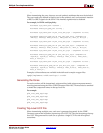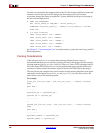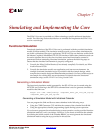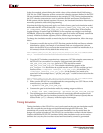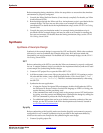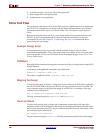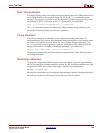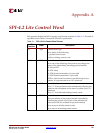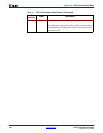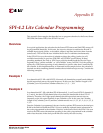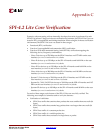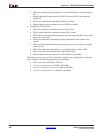
SPI-4.2 Lite v4.3 User Guide www.xilinx.com 133
UG181 June 27, 2008
R
Appendix B
SPI-4.2 Lite Calendar Programming
This appendix lists examples that describe how to program calendars for the Source Status
FIFO and Sink Status FIFO of the SPI-4.2 Lite core.
Overview
In a typical application, the calendars for the Source FIFO status and Sink FIFO status will
be programmed identically. In this case, the user may choose to combine the Rx and Tx
calendar input signals (clocks, write enable, address, and data) and drive them from the
same Source. This will let the user initialize the Rx and Tx calendars simultaneously.
In the SPI-4.2 Lite core, the notion of calendar replaces the polling/packet (or cell)
available functionality in previous POS-PHY and UTOPIA specifications. In these
preceding standards, the Link or ATM Layer polls the channels and the Physical Layer
responds with a “packet available” or “cell available” status. In SPI-4.2 Lite, the polling is
replaced by FIFO status reporting of each channel in a specific order that is controlled by
the calendar. In this implementation, as illustrated in the examples below, the calendar is
inserted as a table containing channel numbers that is initialized at power-up. Consider the
following examples.
Example 1
In a channelized OC-192 with 192 STS-1 channels, all channels have equal bandwidth and
should report their status with equal frequency. In this case, the Calendar Length is 192
(Calendar_Len=191) and the Calendar entries are: 0, 1, 2, …, 191.
Example 2
In a channelized OC-192 with three STS-48 channels (0, 1, and 2) and 4 STS-12 channels (3,
4, 5, and 6), the three STS-48 channels have four times the bandwidth of the 4 STS-12
channels. Therefore, the 3 high-speed channels should report their status 4 times as
frequently as the low-speed channels in one Calendar cycle. In this case, the Calendar
Length is 16 (Calendar_Len=15) and the Calendar entries are: 0, 1, 2, 3, 0, 1, 2, 4, 0, 1, 2, 5, 0,
1, 2, 6.
Once the Calendar is programmed, the user circuitry updates FIFO status in the dual-port
RAM in the Sink block and the SPI-4.2 Lite core sends the updated status information in
the order programmed in the calendar. Likewise, in the Source block, the SPI-4.2 Lite core
receives the FIFO status information according to the order programmed in the calendar
and writes the status in the dual-port RAM to be read by the user circuitry.



